Health Care Management: EHR Implementation Using Lewin's Theory
VerifiedAdded on 2023/04/25
|5
|955
|198
Essay
AI Summary
This essay discusses the application of Kurt Lewin’s Change Management Theory to facilitate the successful implementation of electronic health records (EHR) in a virtual hospital setting. It addresses the challenges faced by nurses, such as time spent on manual data recording and potential resistance to adopting new technologies. The essay highlights how the 'unfreezing,' 'change,' and 'refreezing' stages of Lewin's model can be utilized to overcome these obstacles, emphasizing the importance of direct communication with nursing staff, acknowledging their views, and providing continuous knowledge development and support. By adopting this structured approach, the virtual hospital can enhance the accuracy and range of patient information, ultimately improving the quality of nursing care.
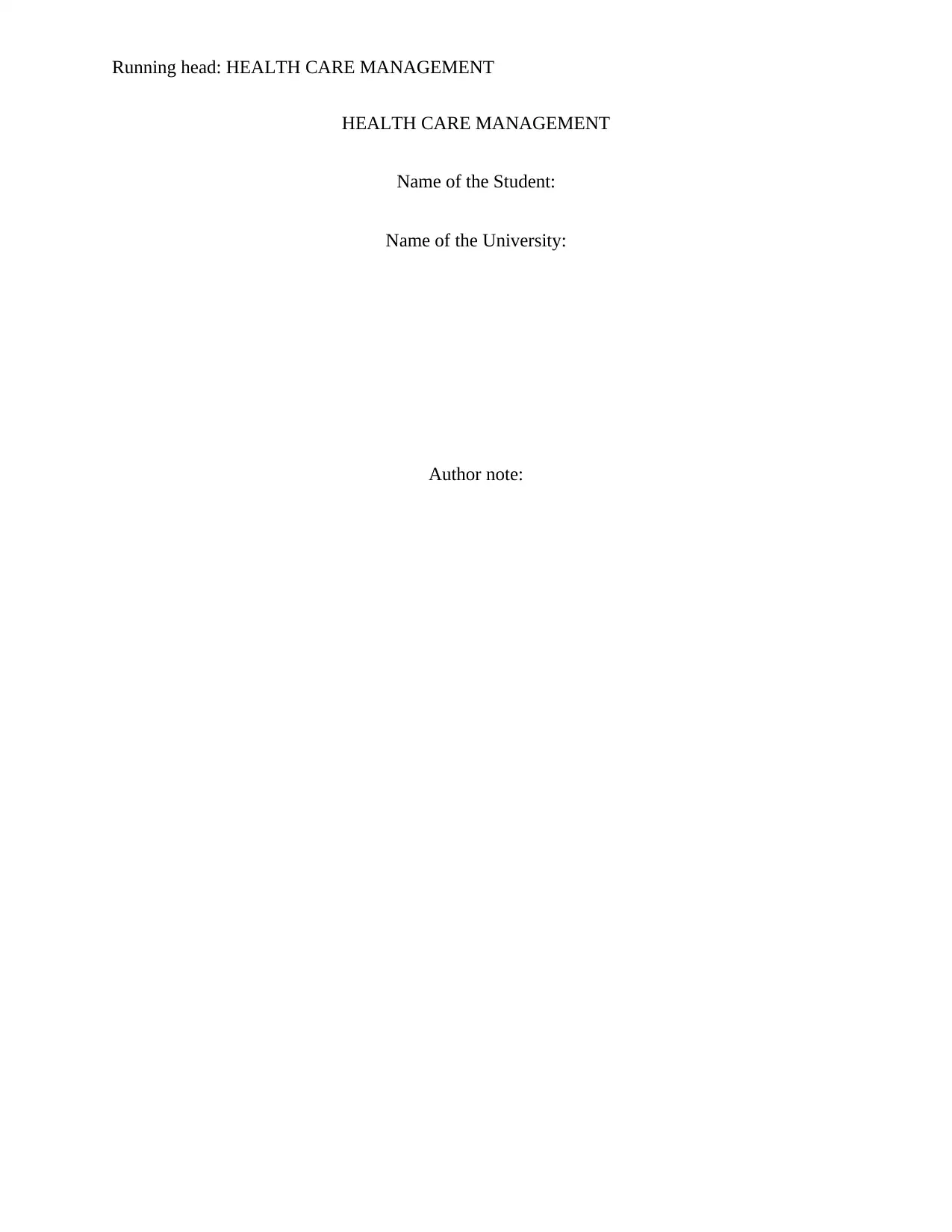
Running head: HEALTH CARE MANAGEMENT
HEALTH CARE MANAGEMENT
Name of the Student:
Name of the University:
Author note:
HEALTH CARE MANAGEMENT
Name of the Student:
Name of the University:
Author note:
Paraphrase This Document
Need a fresh take? Get an instant paraphrase of this document with our AI Paraphraser
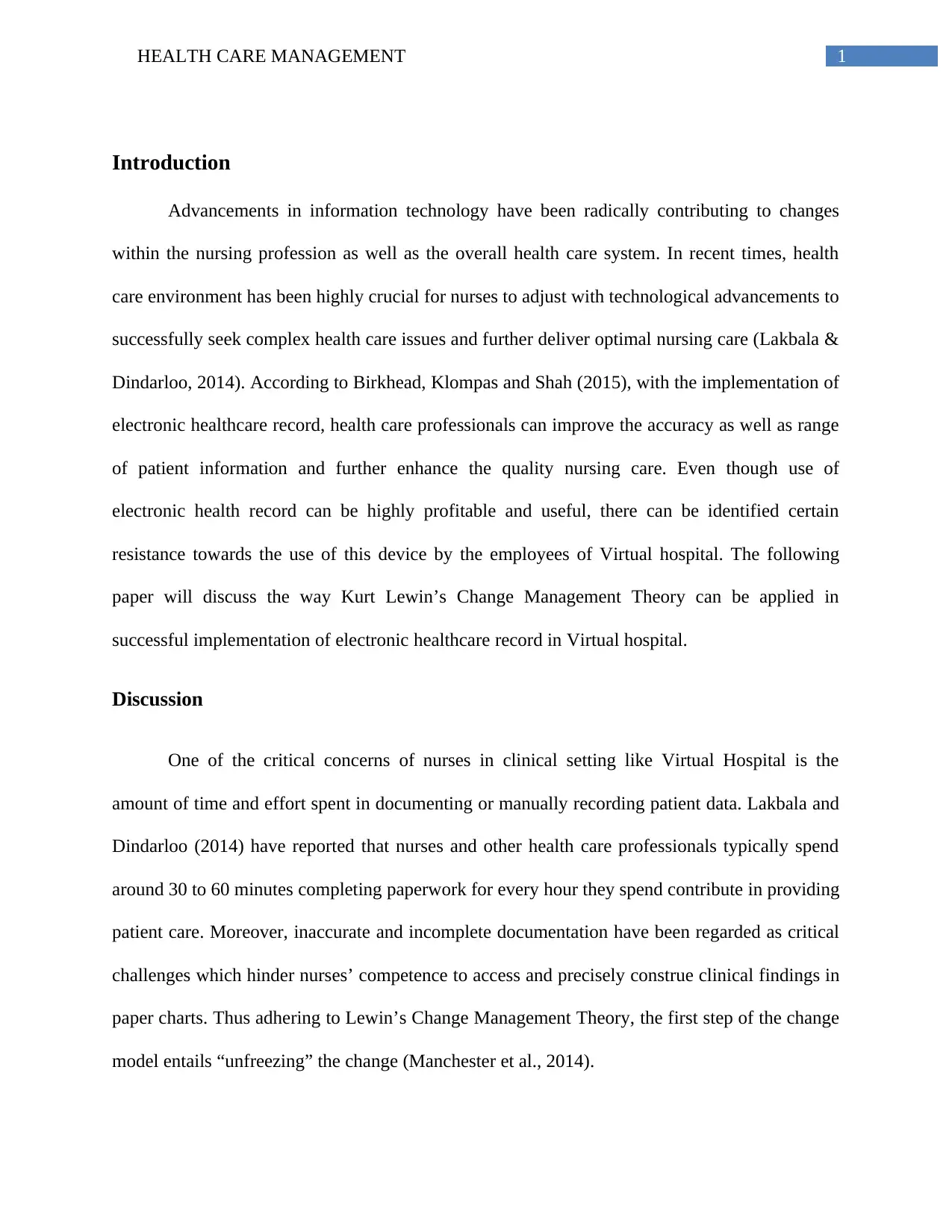
1HEALTH CARE MANAGEMENT
Introduction
Advancements in information technology have been radically contributing to changes
within the nursing profession as well as the overall health care system. In recent times, health
care environment has been highly crucial for nurses to adjust with technological advancements to
successfully seek complex health care issues and further deliver optimal nursing care (Lakbala &
Dindarloo, 2014). According to Birkhead, Klompas and Shah (2015), with the implementation of
electronic healthcare record, health care professionals can improve the accuracy as well as range
of patient information and further enhance the quality nursing care. Even though use of
electronic health record can be highly profitable and useful, there can be identified certain
resistance towards the use of this device by the employees of Virtual hospital. The following
paper will discuss the way Kurt Lewin’s Change Management Theory can be applied in
successful implementation of electronic healthcare record in Virtual hospital.
Discussion
One of the critical concerns of nurses in clinical setting like Virtual Hospital is the
amount of time and effort spent in documenting or manually recording patient data. Lakbala and
Dindarloo (2014) have reported that nurses and other health care professionals typically spend
around 30 to 60 minutes completing paperwork for every hour they spend contribute in providing
patient care. Moreover, inaccurate and incomplete documentation have been regarded as critical
challenges which hinder nurses’ competence to access and precisely construe clinical findings in
paper charts. Thus adhering to Lewin’s Change Management Theory, the first step of the change
model entails “unfreezing” the change (Manchester et al., 2014).
Introduction
Advancements in information technology have been radically contributing to changes
within the nursing profession as well as the overall health care system. In recent times, health
care environment has been highly crucial for nurses to adjust with technological advancements to
successfully seek complex health care issues and further deliver optimal nursing care (Lakbala &
Dindarloo, 2014). According to Birkhead, Klompas and Shah (2015), with the implementation of
electronic healthcare record, health care professionals can improve the accuracy as well as range
of patient information and further enhance the quality nursing care. Even though use of
electronic health record can be highly profitable and useful, there can be identified certain
resistance towards the use of this device by the employees of Virtual hospital. The following
paper will discuss the way Kurt Lewin’s Change Management Theory can be applied in
successful implementation of electronic healthcare record in Virtual hospital.
Discussion
One of the critical concerns of nurses in clinical setting like Virtual Hospital is the
amount of time and effort spent in documenting or manually recording patient data. Lakbala and
Dindarloo (2014) have reported that nurses and other health care professionals typically spend
around 30 to 60 minutes completing paperwork for every hour they spend contribute in providing
patient care. Moreover, inaccurate and incomplete documentation have been regarded as critical
challenges which hinder nurses’ competence to access and precisely construe clinical findings in
paper charts. Thus adhering to Lewin’s Change Management Theory, the first step of the change
model entails “unfreezing” the change (Manchester et al., 2014).
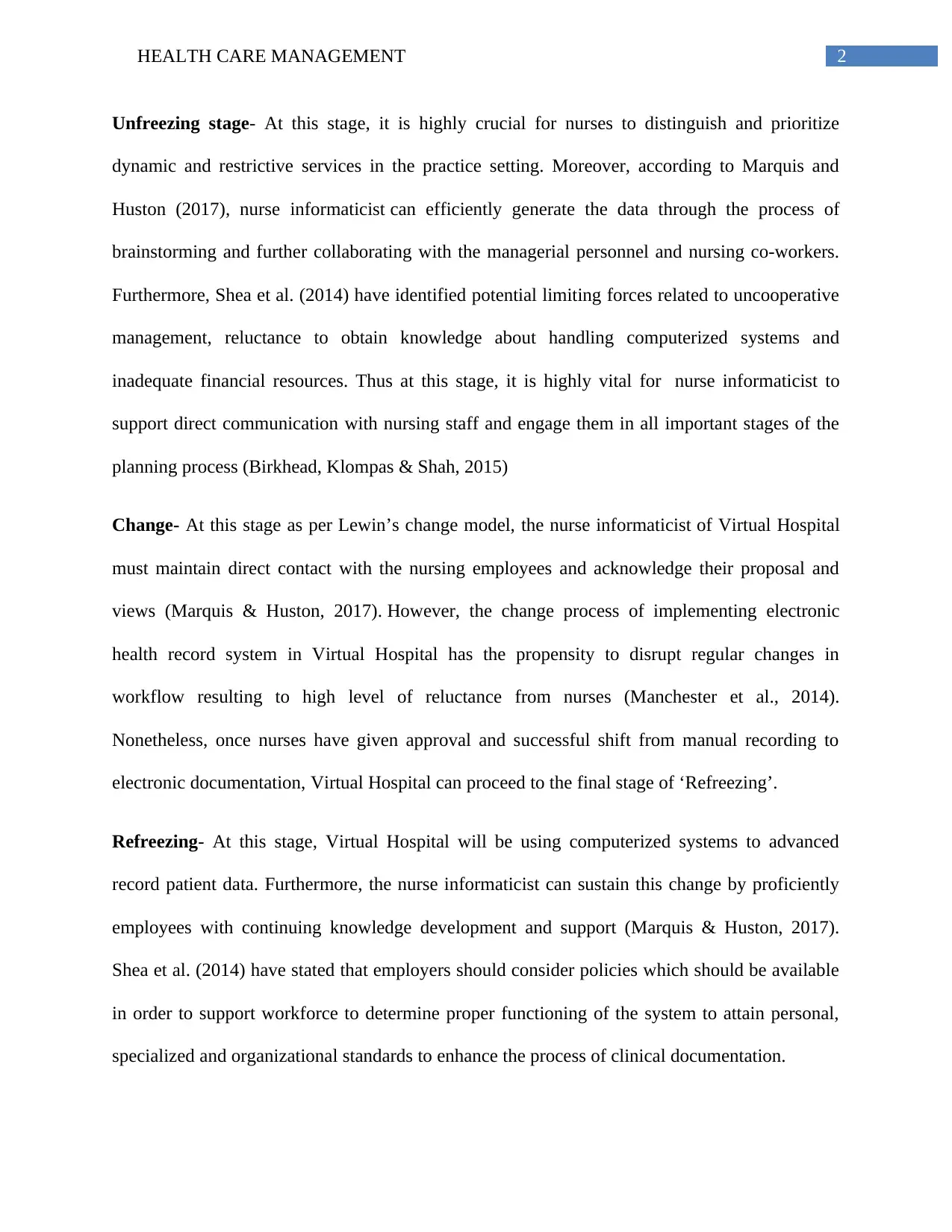
2HEALTH CARE MANAGEMENT
Unfreezing stage- At this stage, it is highly crucial for nurses to distinguish and prioritize
dynamic and restrictive services in the practice setting. Moreover, according to Marquis and
Huston (2017), nurse informaticist can efficiently generate the data through the process of
brainstorming and further collaborating with the managerial personnel and nursing co-workers.
Furthermore, Shea et al. (2014) have identified potential limiting forces related to uncooperative
management, reluctance to obtain knowledge about handling computerized systems and
inadequate financial resources. Thus at this stage, it is highly vital for nurse informaticist to
support direct communication with nursing staff and engage them in all important stages of the
planning process (Birkhead, Klompas & Shah, 2015)
Change- At this stage as per Lewin’s change model, the nurse informaticist of Virtual Hospital
must maintain direct contact with the nursing employees and acknowledge their proposal and
views (Marquis & Huston, 2017). However, the change process of implementing electronic
health record system in Virtual Hospital has the propensity to disrupt regular changes in
workflow resulting to high level of reluctance from nurses (Manchester et al., 2014).
Nonetheless, once nurses have given approval and successful shift from manual recording to
electronic documentation, Virtual Hospital can proceed to the final stage of ‘Refreezing’.
Refreezing- At this stage, Virtual Hospital will be using computerized systems to advanced
record patient data. Furthermore, the nurse informaticist can sustain this change by proficiently
employees with continuing knowledge development and support (Marquis & Huston, 2017).
Shea et al. (2014) have stated that employers should consider policies which should be available
in order to support workforce to determine proper functioning of the system to attain personal,
specialized and organizational standards to enhance the process of clinical documentation.
Unfreezing stage- At this stage, it is highly crucial for nurses to distinguish and prioritize
dynamic and restrictive services in the practice setting. Moreover, according to Marquis and
Huston (2017), nurse informaticist can efficiently generate the data through the process of
brainstorming and further collaborating with the managerial personnel and nursing co-workers.
Furthermore, Shea et al. (2014) have identified potential limiting forces related to uncooperative
management, reluctance to obtain knowledge about handling computerized systems and
inadequate financial resources. Thus at this stage, it is highly vital for nurse informaticist to
support direct communication with nursing staff and engage them in all important stages of the
planning process (Birkhead, Klompas & Shah, 2015)
Change- At this stage as per Lewin’s change model, the nurse informaticist of Virtual Hospital
must maintain direct contact with the nursing employees and acknowledge their proposal and
views (Marquis & Huston, 2017). However, the change process of implementing electronic
health record system in Virtual Hospital has the propensity to disrupt regular changes in
workflow resulting to high level of reluctance from nurses (Manchester et al., 2014).
Nonetheless, once nurses have given approval and successful shift from manual recording to
electronic documentation, Virtual Hospital can proceed to the final stage of ‘Refreezing’.
Refreezing- At this stage, Virtual Hospital will be using computerized systems to advanced
record patient data. Furthermore, the nurse informaticist can sustain this change by proficiently
employees with continuing knowledge development and support (Marquis & Huston, 2017).
Shea et al. (2014) have stated that employers should consider policies which should be available
in order to support workforce to determine proper functioning of the system to attain personal,
specialized and organizational standards to enhance the process of clinical documentation.
⊘ This is a preview!⊘
Do you want full access?
Subscribe today to unlock all pages.

Trusted by 1+ million students worldwide
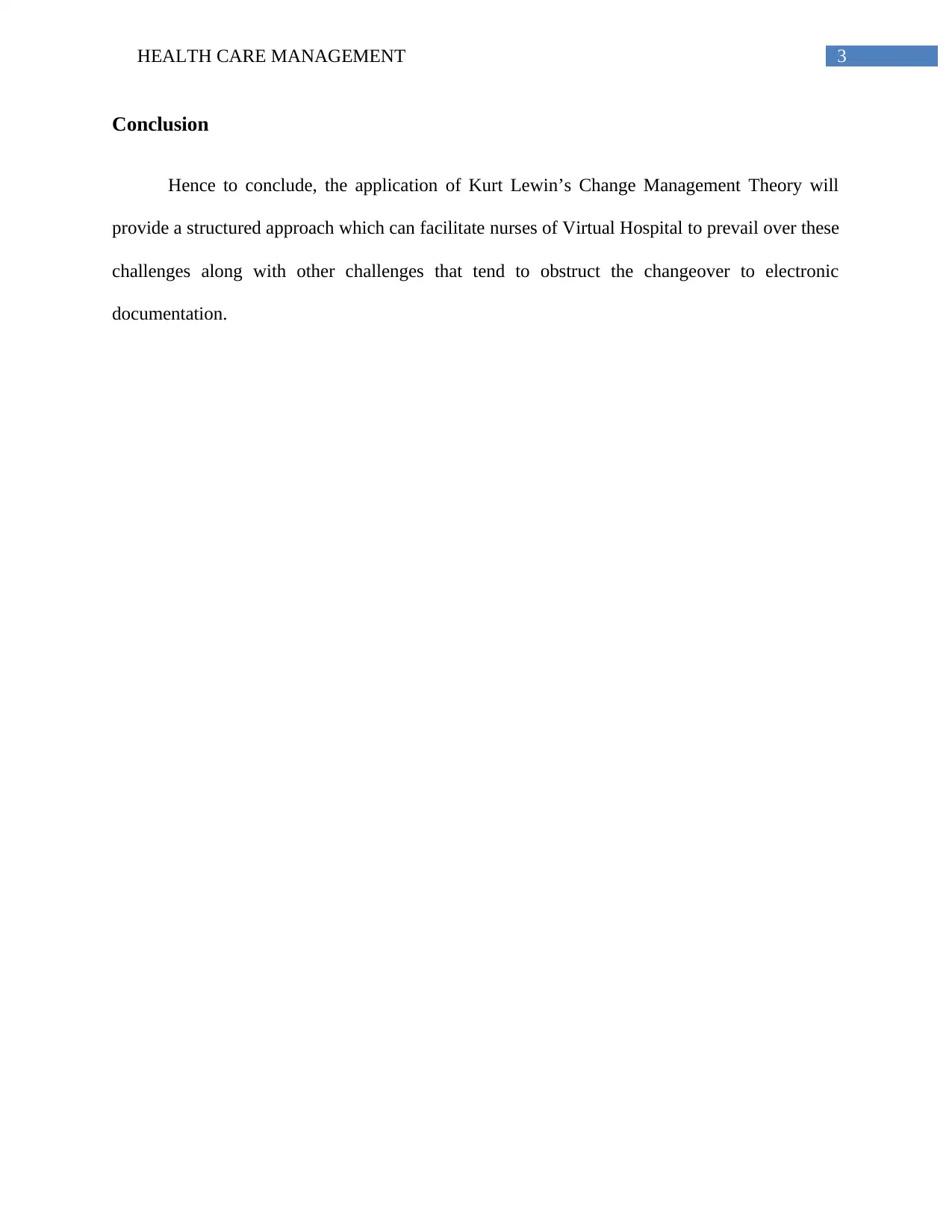
3HEALTH CARE MANAGEMENT
Conclusion
Hence to conclude, the application of Kurt Lewin’s Change Management Theory will
provide a structured approach which can facilitate nurses of Virtual Hospital to prevail over these
challenges along with other challenges that tend to obstruct the changeover to electronic
documentation.
Conclusion
Hence to conclude, the application of Kurt Lewin’s Change Management Theory will
provide a structured approach which can facilitate nurses of Virtual Hospital to prevail over these
challenges along with other challenges that tend to obstruct the changeover to electronic
documentation.
Paraphrase This Document
Need a fresh take? Get an instant paraphrase of this document with our AI Paraphraser
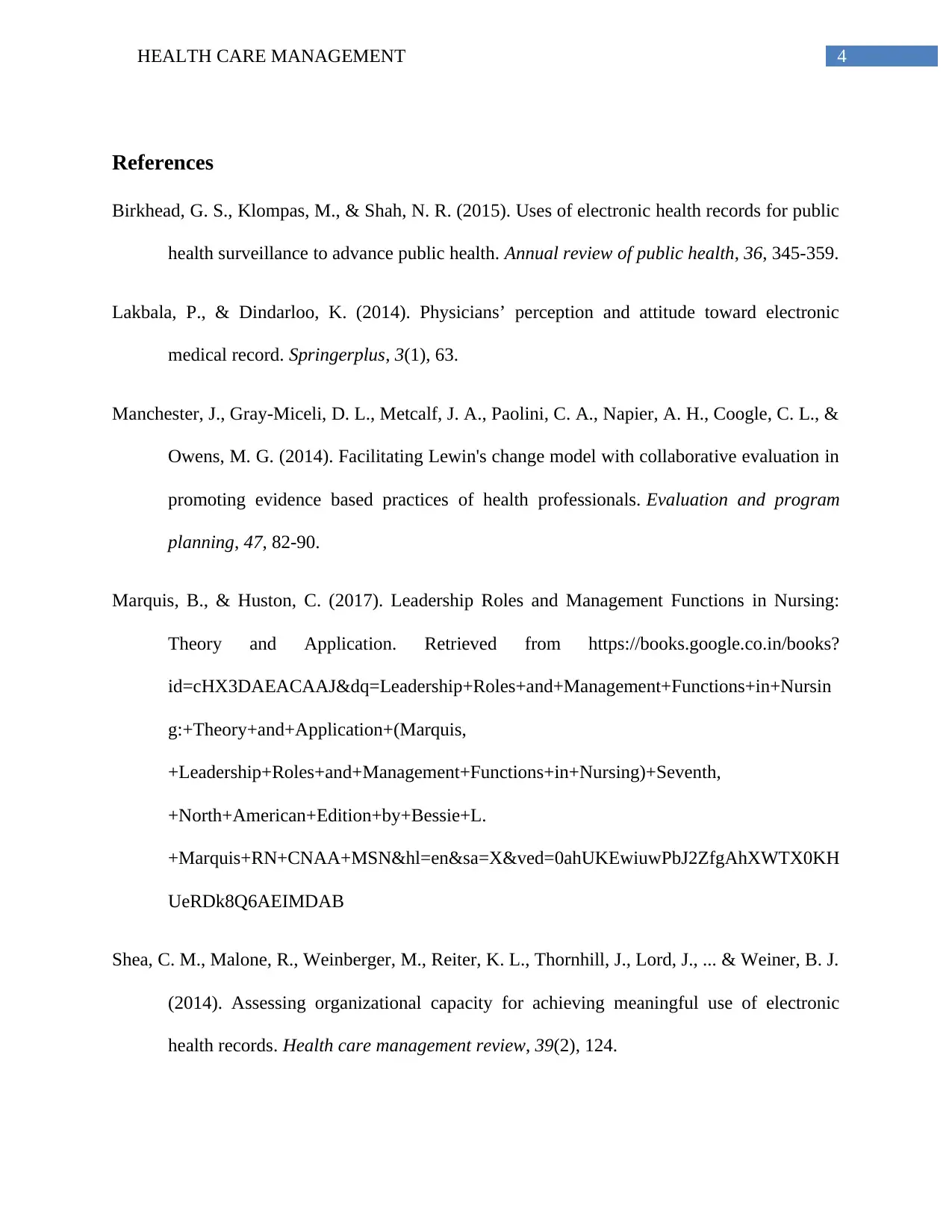
4HEALTH CARE MANAGEMENT
References
Birkhead, G. S., Klompas, M., & Shah, N. R. (2015). Uses of electronic health records for public
health surveillance to advance public health. Annual review of public health, 36, 345-359.
Lakbala, P., & Dindarloo, K. (2014). Physicians’ perception and attitude toward electronic
medical record. Springerplus, 3(1), 63.
Manchester, J., Gray-Miceli, D. L., Metcalf, J. A., Paolini, C. A., Napier, A. H., Coogle, C. L., &
Owens, M. G. (2014). Facilitating Lewin's change model with collaborative evaluation in
promoting evidence based practices of health professionals. Evaluation and program
planning, 47, 82-90.
Marquis, B., & Huston, C. (2017). Leadership Roles and Management Functions in Nursing:
Theory and Application. Retrieved from https://books.google.co.in/books?
id=cHX3DAEACAAJ&dq=Leadership+Roles+and+Management+Functions+in+Nursin
g:+Theory+and+Application+(Marquis,
+Leadership+Roles+and+Management+Functions+in+Nursing)+Seventh,
+North+American+Edition+by+Bessie+L.
+Marquis+RN+CNAA+MSN&hl=en&sa=X&ved=0ahUKEwiuwPbJ2ZfgAhXWTX0KH
UeRDk8Q6AEIMDAB
Shea, C. M., Malone, R., Weinberger, M., Reiter, K. L., Thornhill, J., Lord, J., ... & Weiner, B. J.
(2014). Assessing organizational capacity for achieving meaningful use of electronic
health records. Health care management review, 39(2), 124.
References
Birkhead, G. S., Klompas, M., & Shah, N. R. (2015). Uses of electronic health records for public
health surveillance to advance public health. Annual review of public health, 36, 345-359.
Lakbala, P., & Dindarloo, K. (2014). Physicians’ perception and attitude toward electronic
medical record. Springerplus, 3(1), 63.
Manchester, J., Gray-Miceli, D. L., Metcalf, J. A., Paolini, C. A., Napier, A. H., Coogle, C. L., &
Owens, M. G. (2014). Facilitating Lewin's change model with collaborative evaluation in
promoting evidence based practices of health professionals. Evaluation and program
planning, 47, 82-90.
Marquis, B., & Huston, C. (2017). Leadership Roles and Management Functions in Nursing:
Theory and Application. Retrieved from https://books.google.co.in/books?
id=cHX3DAEACAAJ&dq=Leadership+Roles+and+Management+Functions+in+Nursin
g:+Theory+and+Application+(Marquis,
+Leadership+Roles+and+Management+Functions+in+Nursing)+Seventh,
+North+American+Edition+by+Bessie+L.
+Marquis+RN+CNAA+MSN&hl=en&sa=X&ved=0ahUKEwiuwPbJ2ZfgAhXWTX0KH
UeRDk8Q6AEIMDAB
Shea, C. M., Malone, R., Weinberger, M., Reiter, K. L., Thornhill, J., Lord, J., ... & Weiner, B. J.
(2014). Assessing organizational capacity for achieving meaningful use of electronic
health records. Health care management review, 39(2), 124.
1 out of 5
Related Documents
Your All-in-One AI-Powered Toolkit for Academic Success.
+13062052269
info@desklib.com
Available 24*7 on WhatsApp / Email
![[object Object]](/_next/static/media/star-bottom.7253800d.svg)
Unlock your academic potential
Copyright © 2020–2025 A2Z Services. All Rights Reserved. Developed and managed by ZUCOL.



